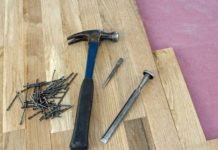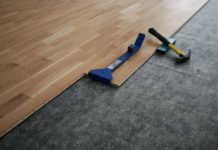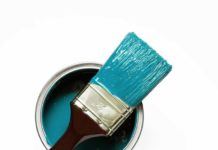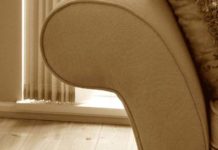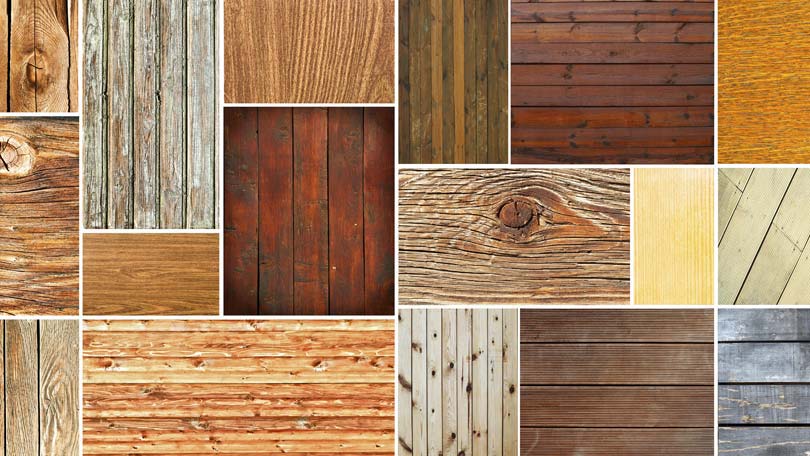
Hardwood floors are by far the most popular choice in wood flooring, and for good reason. First, they wear exceptionally well, and second, there’s an unlimited selection of wood types, colors, and grains to choose from. Let’s look at some of the incredible choices that are available today
Choose the Installation Method
The two most common types of hardwood flooring are A. the time-honored method of tongue and groove boards that are nailed into the subfloor, and B. the newer, engineered floors, which are either locked together or glued together.
Traditional plank floors are usually 3/4” thick, although they can range all the way down to a mere 5/16”. Remember that over the life of a plank floor, you are apt to refinish it a few times, and each sanding removes some of its depth, so thicker is better for the long run. If you’re simply “dressing” your home to sell, that might not be as much of a consideration. Plank floors are tapped into place and nailed through into the subfloor, usually using a pneumatic nailgun. Inconsistencies in height and butt ends are smoothed out in the sanding and finishing.
Engineered floors are the new “hot” new trend in flooring, and they feature some distinct advantages. First they are constructed on a plywood substrate, so are less prone to the vicissitudes of wood, such as warping, checking or buckling. Secondly they use a veneer of hardwood as the top layer which is usually pre-finished thus saving time and work. Do pay attention to thickness of this top layer, the “wear layer” by inspecting the flooring from the ends. Remember that you may need to refinish your new floor in time, and you may want to opt for a thicker (and more expensive” flooring that features a ticker top veneer. Thirdly and perhaps most appealing is that they are engineered to fit and “snap” together with a minimum of “persuasion.” In fact, the newest trend is the Lock and Fold joining method, where the two boards offer locking male/female edges that lock into place without the usually blocking and tapping into place more common with older styles. Of all the types of hardwood flooring, pre-finished engineered floors are by far the fastest-growing category.
What Width do I Want?
In the old, old days, floors tended to be wide width planks that were sawn thick. These floors were often softwoods such as hemlock, pine or Douglas fir, but sometimes oak or cherry. Wide plank floors have a great rustic look to them and are favored for colonial homes, farmhouses or rustic vacation cottages and camps.
As milling and machining became more prevalent, floor plank widths tended to shrink to skinnier widths. Look around and chances are you’ll notice that most hardwood floors are the 2 ¼ inch width that became the norm almost one hundred years ago. This width is still common today, and while it offers more width-wise stability than a wide plank, it also gives the opportunity for more color variation over the course of the floor, as it will require many more strips. But remember, that also translates into more installation work.
Remember that the wider the board, the more prone to movement in reaction to seasonal shifts in temperature and humidity. Although you can purchase straight grain boards that are more expensive but offer better performance. Engineered floors are now coming in wider widths, which offers the consumer the look of an older, rustic floor, but with the modern convenience and performance of an engineered product.
Let’s Look at Length
Both plank flooring and engineered flooring comes in various lengths, generally from 12 inches to 84 inches, but naturally you can get custom-milled pieces in longer lengths. Longer board length creates the illusion of more space when the boards are oriented to run into the room. However, shorter board lengths offer more variety of color and an interesting pattern. Engineered floors tend to be packaged with many shorter pieces, so bear that in mind when purchasing. Imported woods and lower grades tend to come in shorter lengths. When installing random lengths, it’s important to mix it up and not have butt end seams near each other, but rather stagger the boards to create a truly random pattern.
Bevels and Scrapes
While the majority of flooring is edge-to-edge flat, you can also purchase planks with a beveled edge for an interesting look. A word of caution though, those bevels can make it harder moving heavy furniture, and smaller wheels can sometimes catch in them, creating a scar. Also refinishing a beveled-edge floor is more problematic.
Hand-Scraped flooring is the new rage, and it offers a wonderful texture to behold. “Hand-Scraped” may describe the look of the plank, but often it is machine milled. Truly hand-scraped products will be more expensive but offer an interesting look that is coveted by aficionados
Plastic Fantastic
What do you do when you want the warm, inviting look of a hardwood floor, but have lots of foot traffic, such as in a store, restaurant or lounge? Plastic to the rescue! Acrylic impregnated hardwood floors are perfect for those applications. This flooring is pressure treated with acrylic resins that fill any voids in the wood, such as the pores. The acrylic serves to add durability and increased hardness to the wood, and makes it much less susceptible to water damage. You’ll still need to maintain the floor regularly, but the wear will be noticeably less than traditional hardwood flooring. Available in many species and colors, acrylic impregnated flooring needs to be glued down or “floated.”
Finished or Unfinished?
Once you’ve reviewed all the types of hardwood flooring available, then it’s time to choose your finish. Depending on the look you want, you may choose finished or unfinished flooring and then finish on site, once installed. Most engineered flooring is sold pre-finished, and that holds a lot of appeal for those looking to get the hardwood look and feel at the lowest price. It gives a lot of bang for the buck, but the lower grades will be more uniform, and certainly less interesting (especially in the darker colors requiring more stain) than either the higher grades, or going with a custom finish that is done on site. Remember too, that certain woods can have dramatic color change over time, and it would be a shame to blot their natural color out with a heavy dark stain. For example, both cherry and Douglas fir will redden and darken significantly over the years, and you’ll have a beautiful, warm natural color. Our recommendation would be to finish them with light stain or clear finish and allow the wood to ripen with maturity.

